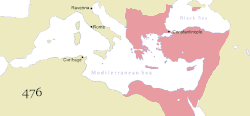 Global Information
Global InformationByzantine Empire under the Heraclian dynasty information
Byzantine Empire Βασιλεία Ῥωμαίων (Ancient Greek) Imperium Romanum (Latin) | |||||||||||||
|---|---|---|---|---|---|---|---|---|---|---|---|---|---|
| 610–711 | |||||||||||||
 The calvary cross potent motif was commonly minted on coins by various emperors. | |||||||||||||
 The Byzantine Empire after the death of Emperor Heraclius | |||||||||||||
| Capital | Constantinople | ||||||||||||
| Common languages | Greek Latin | ||||||||||||
| Government | Monarchy | ||||||||||||
| Emperor | |||||||||||||
• 610–641 | Heraclius | ||||||||||||
• February–May 641 | Constantine III | ||||||||||||
• February–October 641 | Heraclonas | ||||||||||||
• 641–668 | Constans II | ||||||||||||
• 668–685 | Constantine IV | ||||||||||||
• 685–695 · 705–711 | Justinian II | ||||||||||||
| Historical era | Late Antiquity to Early Middle Ages | ||||||||||||
• Accession of Heraclius | 5 October 610 | ||||||||||||
• Second deposition and execution of Justinian II | 4 November 711 | ||||||||||||
| |||||||||||||
| Heraclian dynasty | ||
|---|---|---|
| Chronology | ||
|
||
| Succession | ||
|
||
| History of the Byzantine Empire |
|---|
 |
| Preceding |
|
| Early period (330–717) |
|
| Middle period (717–1204) |
|
| Late period (1204–1453) |
|
| Timeline |
| By topic |
|
|
|
The Byzantine Empire was ruled by emperors of the dynasty of Heraclius between 610 and 711. The Heraclians presided over a period of cataclysmic events that were a watershed in the history of the Empire and the world. Heraclius, the founder of his dynasty, was of Armenian and Cappadocian (Greek) origin.[1][2][3] At the beginning of the dynasty, the Empire's culture was still essentially Ancient Roman, dominating the Mediterranean and harbouring a prosperous Late Antique urban civilization. This world was shattered by successive invasions, which resulted in extensive territorial losses, financial collapse and plagues that depopulated the cities, while religious controversies and rebellions further weakened the Empire.
By the dynasty's end, the Empire had been transformed into a different state structure: now known in historiography as medieval Byzantine rather than (Ancient) Roman, a chiefly agrarian, military-dominated society that was engaged in a lengthy struggle with the Muslim Rashidun Caliphate and successor Umayyad Caliphate. However, the Empire during this period became also far more homogeneous, being reduced to its mostly Greek-speaking and firmly Chalcedonian core territories, which enabled it to weather these storms and enter a period of stability under the successor Isaurian dynasty.
The Heraclian dynasty was named after the general Heraclius the Younger, who, in 610, sailed from Carthage, overthrew the tyrant Phocas, and was crowned Emperor. At the time, the Empire was embroiled in a war with the Sassanid Persian Empire, which in the next decade conquered the Empire's eastern provinces. After a long and exhausting struggle, Heraclius managed to defeat the Persians and restore the Empire, only to lose these provinces again shortly after to the sudden eruption of the Muslim conquests.
His successors struggled to contain the Arab tide. The Levant and North Africa were lost, while in 674–678, a large Arab army besieged Constantinople itself. Nevertheless, the state survived and the establishment of the Theme system allowed the imperial heartland of Asia Minor to be retained. Under Justinian II and Tiberius III the imperial frontier in the East was stabilized, although incursions continued on both sides. The latter 7th century also saw the first conflicts with the Bulgars and the establishment of a Bulgarian state in formerly Byzantine lands south of the Danube, which would be the Empire's chief antagonist in the West until the 12th century.
- ^ Kaegi 2003, p. 21.
- ^ Geanakoplos 1984, p. 344.
- ^ Treadgold 1997, p. 287.